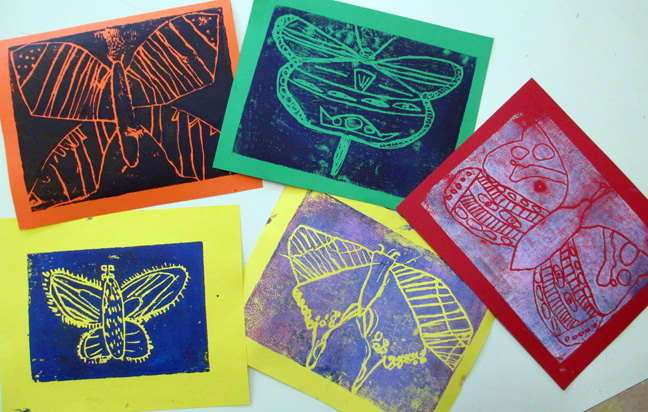The second graders will soon be learning about butterflies and life cycles in science class. To get a head start, they are studying symmetry in butterflies in Art. (Plus now they now the differences between butterflies and moths) After drawing symmetrical drawings, students transferred their images onto foam, and carved in the lines. After printing the foam plate, they will create collages using the many versions of prints they experimented with.
Scratch paper, from scratch February 5, 2014
My 2/3 spec. needs class made their own home-made scratch paper. First, they colored oak tag with oil pastels, being sure to cover the entire board with a thick, heavy layer. Second, the students painted a thin even layer of black acrylic paint on top (we used foam brushes so no streaks). After letting the paint dry, they drew their designs with wood styluses, scratching away the black to reveal the color underneath.
While the lines of the homemade paper are more rough and a tad smudgier than store bought paper, the students declared the homemade kind much better!!
Hidden Names December 9, 2013
The 2nd graders are currently working on Greek amphora designs. Both scratch paper and sgrafitto clay techniques are coming up, but the 2/3 spec. needs class began the unit hiding their names in the designs. Working in horizontal rows, the students wrote their names over and over, followed by coloring the letters with patterns. After cutting out the amphora shape, the names are almost unrecognizable, and just beautiful texture!
Abstract Matisse Collages November 15, 2013
2nd graders are just finishing up an abstract collage. Inspired by the cut-outs of Henri Matisse, students practiced cutting organic and geometric shapes. They selected colors based on the color wheel’s warm and cool colors. And finally, they highlighted some shapes with yarn lines. Henri’s Scissors is a great picture book that explains how Matisse went from painter to collage artist!
Science Fair Flowers May 30, 2013
Today was the Morse School Science Fair! The kindergarteners and 2nd graders were displaying art projects in addition to their science exhibits. The kindergarteners in Mr. K’s class created huge paper mache flowers (strawberry, pine, and daffodil), and came to the Art Studio to paint their creations. Their partially finished paintings from Art were also on display. The kindergarteners were focused on the important parts of a flower: stem, leaves, petals, pollen, pistil, and stamen.
The 2nd grade table showcased some of the life-cycle flower pots, which are nicely sprouting! The larger leaves will be lettuce and the smaller sprouts will be small white flowers called alyssum.
Life Cycles coming to life! May 4, 2013
The 2nd graders finished their coil flower pots, and are now scratching in their designs. The pots have not been fired, and the students are practicing a technique called sgraffito, where they scratch through a layer of glaze to show the clay underneath. Students are illustrating life cycles on the pots, either the life cycle of a frog, butterfly, or flower. If you look closely in 2 of the photos, you’ll see their sketches that they are working from. After the pots are fired, they will be planting seeds of their own!
Coiling April 9, 2013
The 2nd graders are just starting to create coiled flower pots. Once the pots have been coiled all the way, they will use the technique of sgraffito to draw life cycles of frogs, butterflies, and plants on the sides. What a fun way to tie into their science curriculum! More pictures in a few weeks of the finished pots.
Story Quilts March 28, 2013
2nd graders just wrote short stories about themselves and a family member. These self portraits were inspired by the story quilt, Tar Beach by Faith Ringgold. Ringgold painted the famous quilt, and the continued to win a Caldecott Honor for translating her quilt into a picture book. If you want to see (and read!) more 2nd grade work, plan to come to the Morse School Art Show, at Gallery 263! The show will be up April 8-13th.
Painters in action December 11, 2012
The second graders are painting abstract compositions made from stencils. We talked about how artists achieve “movement” in their paintings, even though the paintings don’t move at all. Their swirly, wiggly, dancing shapes were much more interesting than squares and circles.
Now, the students are painting the drawing. They are ‘battling’ two colors together to make a third color inside every shape. This will begin a conversation about warm and cool colors.
Greek sgraffito November 6, 2012
The second graders are learning about ancient Greece in their social studies class. In Art, they created stories about Olympians, Gods, and Goddesses on amphoras. Amphoras are 2 handled ceramic vases used by the Greeks. The ancient Greeks used a technique called sgraffito to draw the images on the vases. Sgraffito means to scratch…the top color is scratched off to reveal a different color clay underneath.
The 2nd graders practiced theirs sgraffito skills twice. First, they used scratch paper, revealing gold/silver underneath the black layer. Second, they used clay, scratching through a layer of red glaze to reveal the white clay underneath.




























